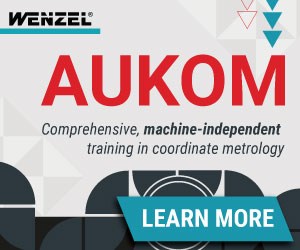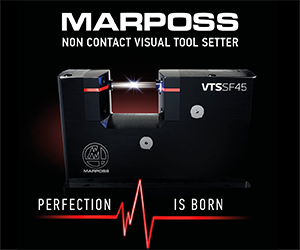Applying New Laser-Scanning Technology
Here’s why many of today’s manufacturers are considering retrofitting CMMs and articulated measuring arms with laser scanners.
Alex Lucas, business development manager/scanning products for Nikon Metrology, notes that every manufactured part presents its own flavor of inspection or reverse-engineering challenges. There could be a combination of planar and freeform surfaces, intricate radii, highly reflective surfaces, or complex features such as those found in castings and dies. Inspection tasks might include comparisons of scanned point clouds to CAD models, updating designs, creating CAD models for reverse-engineering or rapid-prototyping tasks and so on. Laser-scanning technology is advancing and can be retrofitted to existing CMM or articulated arms to suit specific part-measurement requirements. Mr. Lucas points to the following advantages offered by the latest laser scanning and software technology for these applications:
• Larger measurement coverage—While many touch probes might achieve input rates of one point per second, laser-scanning stripes can range in width from 50 to 200 mm and scan tens of thousands of data points per second.
• Higher speed—Using laser scanning, even complex 3D castings, production dies, turbine blades and plastic parts can be scanned in a matter of minutes.
• Offline reporting—Transferring measurement data to PC-based reporting software can significantly reduce inspection time and speed time to market. Incorporating color-coded visuals and tabular data can shorten the approval process and make it easier to share information.
• Quick, simple retrofits—A range of laser-scanning options are compatible with many existing CMMs and articulated–arm devices. Retrofits can often be accomplished in a matter of hours, and select laser scanners are compatible with both equipment platforms.
• Ability to automate—Integrated software packages are available for an automated process that includes measuring, gathering data, comparing scanned data to CAD models, and generating reports with both visual representations and tabular data.
• Scanning without re-orientation—New technology such as cross-scanning combines multiple scanners and digital cameras that can scan complex parts and features without re-orienting the part.
Mr. Lucas notes that there are many choices for CMM-based laser-scanning. Numerous companies make entry-level, single-stripe laser scanners that provide approximately a 50-mm stripe width, generate 20 to 25 stripes per second, and input close to 20,000 points per second while maintaining an error tolerance of 20 to 25 microns. For more demanding inspection tasks, Nikon Metrology manufactures a laser scanner featuring a 60-mm stripe width while scanning at 75 stripes-per-second and maintaining an error tolerance of 9 microns. Scanners are also available with smaller fields of view for digitizing little, detailed objects with higher point densities and tolerances down to 4 microns.
For larger objects, hand-held laser scanners or versions that attach to articulated arms are available to make walk-around scanning easier. Depending on the type of scanner, stripe widths can vary between 50 and 200 mm, and digital cameras capture more than 1,000 points per stripe. This provides optimum resolution for efficiently scanning freeform surfaces and features. Cross-scanners that incorporate multiple scanners and cameras are also available for measuring or reverse-engineering large parts.
Today’s laser scanners also feature automatic real-time adjustment of sensor settings for each individual point along the laser stripe to effectively scan highly reflective surfaces or those that vary in color. This meets the former challenge of scanning highly reflective surfaces, which often required spraying a part with a matte coating to eliminate reflective data and other extraneous noise from being captured in a scan.
Mr. Lucas also points out the importance of software compatibility. Nikon Metrology maintains partnerships with a number of inspection software providers and also provides its own point-cloud-processing solution. Laser scanning can input tens of thousands of points per second, so effective inspection software must be able to handle a large volume of inspection data (up to 100 million points). Software also should provide tools such as automated feature-detection algorithms; full part comparison to CAD or STL files; a complete set of 2D and 3D features; geometric dimensioning and tolerancing (GD&T) capability; specialized measuring routines for wall thickness, flush and gap, and directional comparisons; dedicated inspection modules such as turbine-blade inspection; and off-line modules that enable users to use CMMs or articulated arms for inspection and personal computers for creating or modifying reports and models.
Related Content
How to Choose the Right Cut Off When Measuring Roughness
Measurement results for surface finishing parameters can vary depending on the filter parameter (Lc), also known as the cutoff.
Read MoreBallbar Testing Benefits Low-Volume Manufacturing
Thanks to ballbar testing with a Renishaw QC20-W, the Autodesk Technology Centers now have more confidence in their machine tools.
Read MoreChoosing the Correct Gage Type for Groove Inspection
Grooves play a critical functional role for seal rings and retainer rings, so good gaging practices are a must.
Read MoreBuilding an Automation Solution From the Ground Up
IMTS 2022 provides visitors the opportunity to meet with product experts to design automation solutions from scratch.
Read MoreRead Next
The Cut Scene: The Finer Details of Large-Format Machining
Small details and features can have an outsized impact on large parts, such as Barbco’s collapsible utility drill head.
Read More3 Mistakes That Cause CNC Programs to Fail
Despite enhancements to manufacturing technology, there are still issues today that can cause programs to fail. These failures can cause lost time, scrapped parts, damaged machines and even injured operators.
Read MoreObscure CNC Features That Can Help (or Hurt) You
You cannot begin to take advantage of an available feature if you do not know it exists. Conversely, you will not know how to avoid CNC features that may be detrimental to your process.
Read More
.jpg;width=70;height=70;mode=crop)














.png;maxWidth=300;quality=90)

.png;maxWidth=300;quality=90)








